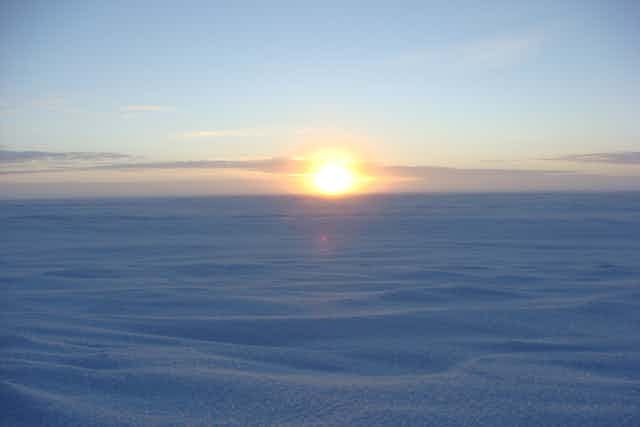It is just over 50 years since French scientist Claude Lorius dropped some glacier ice in his whisky and started a quest that continues today. Lorius was studying glaciers in Antarctica and wondered if the air bubbling out of some ice he had drilled that day might carry information from the past.
The answer to that question was “yes”. We now know that ice cores carry a rich archive of past information in the bubbles and the ice itself.
This week the world’s ice core community is meeting in Hobart as the 24 nations of the International Partnerships in Ice Core Sciences (IPICS) gather. IPICS was formed in 2004 to help coordinate and guide this highly collaborative branch of science. Large ice-coring projects involve challenging logistics in the harshest environments on earth, so well-developed and coordinated programs are important.
Secrets in the ice

The field of ice core palaeoclimate is now a mature branch of earth science that has provided revolutionary insights into the climate of the past 800,000 years. No insight is more potent than the revelation that global temperature and carbon dioxide (CO2) march in lock step through the ice ages. Current CO2 levels sit far above the natural range (now just over 400 parts per million (ppm), or more than 100 ppm higher than any time in 800,000 years).
Drilling an ice core is a significant logistical exercise. It can take several years of preparation, and for deep cores (1km to over 3km deep) requires several summer seasons in the field to drill. Shallower cores, up to several hundred metres in depth, can be drilled in a single field season, so it is possible to build up a broader array of these cores across Antarctica.
Over the years a number of long, deep ice core records have been extracted from Antarctica and Greenland, along with many shorter cores from polar and mountain glaciers around the world. There is a pressing need to continue the work. Ever-improving analytical methods are delivering more information from ice cores more efficiently, but there are still too few core sites to build a reliable picture of past change.
For example, recent research to reconstruct the climate for the last 2,000 years relied on just four cores in East Antarctica: a challenge comparable to understanding Australia’s climate from just four or five weather stations.
As we seek to mitigate the worst impacts of climate change and adapt to inevitable changes, it is critical to understand how the climate system behaves in the longer term.
Looking to the future
We know which questions we need to answer first. At the most basic level, we need to expand our network of ice cores so that we can better study climate variations over the last couple of millennia.
This work has proved important for testing climate models. We can use information from ice cores to see how accurately climate models recreate past climates, which helps us assess how useful they are for predicting the future. For Australia, ice cores have expanded our understanding of factors influencing drought.
The most ambitious priority for ice core science is the challenge of recovering a core that extends to well over a million years ago. The oldest ice core presently reaches just 800,000 years, but there is a strong prospect that ice over a million years old exists near the bottom of the Antarctic icecap (more than 3km below the surface).
Around a million years ago, ice age cycles shifted their pacing from 41,000 years’ to 100,000 years’ length. We don’t know what caused this shift. An ice core covering this period would allow us to extract a direct record of CO2 and see what role, if any, it may have played.
Another challenge that requires a major deep drilling effort is to explore the warm period before the last ice age began, around 100,000 years ago. This warm period, or interglacial, peaked around 2˚C warmer than pre-industrial times. Sea levels then were 6-9 metres above present.
New ice core records from Greenland and Antarctica would help to understand how fast sea levels rose and how the pattern and timing of warming varied across the planet. At the moment, the Greenland ice core records of this period are discontinuous and incomplete, while Antarctica offers the prospect of very detailed ice cores that tell more about the size of the Antarctic ice sheet through this period of higher sea level.
Such information would be valuable in understanding the rates and extent of sea level rise that face us in the future.
Ice core scientists are also looking to projects that might help us understand complexities of ice flow as well as purely climatic information. These could drive new drilling in challenging places like ice streams.
A further pressing issue that is being discussed is the rapid loss of icecaps in mountainous regions. These vanishing glaciers hold climate information that will soon be lost to us, so the ice core community is urgently looking to drill and archive this precious resource.

